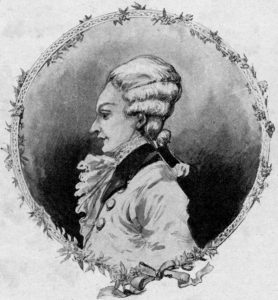29 Style Evolution of Marie Antoinette – Léonard Autié

c. 1746/1751-March 20, 1820
Although the exact date of his birth has not been firmly established, Léonard Alexis Autié was most likely born between 1746 and 1751 in the town of Pamiers in the southwest of France. His parents were domestic servants. Léonard tried and failed to make a name for himself as a hairdresser in Marseilles, Toulouse, and Bordeaux before arriving in Paris in 1769. There he began styling the hair of the actresses of Nicolet’s Theater.
In 1770, Léonard began dressing the hair of the Marquise de Langeac, who was to become one of Marie Antoinette’s ladies at court. In time, he also began dressing the hair of the Madame du Barry, the last mistress of Louis XV, at Versailles. Urged by both women, Marie Antoinette agreed to meet Léonard in 1772 with an eye to replacing her current hairdresser. The young dauphine was so pleased with Léonard’s work that she decided to retain his services and only lend him out to her best friends. He became known as Coiffeur de la Reine, hairdresser to the Queen. Léonard, along with Rose Bertin, was allowed unprecedented access to Marie Antoinette, and like the marchande de modes, was allowed complete freedom to develop his creations. Although Léonard was fond of Rose Bertin, he was also extremely competitive and jealous of her successes. Spurred by that jealousy, in 1774 Léonard created the pouf sentimental for the Duchess of Chartres. It was comprised of fourteen yards of gauze and numerous plumes waving from the top of a tower. Two was figures representing the Duke of Beaujolais as a babe in his nurse’s arms, adorned the pouf, also with a parrot eating cherries and a little African boy. Soon the women of Paris were competing to see who could put the most outlandish things in their hair. And the heights were rising. Léonard pushed himself to go even further, inventing the hedgehog pouf or hérisson and the zephyr, a style comprised of a moving garden of brightly colored flowers.
Léonard was so successful that he started a hair-dressing school and studio, the Académie de coiffeur (“a virtual House of Léonard”); he was joined by his two brothers, Pierre and Jean-François, in the enterprise. Later, both brothers would use the name Léonard causing much confusion. By 1787, Léonard no longer had to dress hair, and began a new career as an opera impresario. The Théâtre de Monsieur opened on 26 January 1789, producing Italian opera on a year-round basis.
In June 1791, Léonard’s brother Jean-François Autié accompanied the Duke de Choiseul during the royal family’s doomed flight to Varennes. After the royal family’s arrest, Jean-François went abroad and was joined there by Leónard-Alexis. Three months later, Léonard-Alexis returned to Paris. As the Revolution progressed, Léonard-Alexis left France again and eventually went to Russia. Jean-François remained in France and, due to his involvement in the flight to Varennes, was guillotined on 25 July 1794. Léonard-Alexis did not return to France until 1814, after Louis XVIII was restored to the throne.
Léonard-Alexis Autié died in Paris on March 20, 1820.
Bibliography of Sources:
“Léonard-Alexis Autié”, Wikipedia: The Free Encyclopedia. Accessed June 5, 2019. https://en.wikipedia.org/wiki/Léonard_Autié
Bashor, Will. Marie Antoinette’s Head: The Royal Hairdresser, the Queen, and the Revolution. Guilford, Connecticut: Lyons Press, 2013.
Image Citation:
Fig. 1. Artist unknown, Léonard-Alexis Autié. 18th century, scan from: Souvenirs de Léonard, coiffeur de la reine Marie-Antoinette. Paris: A. Fayard, 1905. Available from: Wikipedia: The Free Encyclopedia. Accessed May 14, 2019. https://commons.wikimedia.org/wiki/File:Souvenirs_de_L%C3%A9onard_1905_cover_portrait.png.


Feedback/Errata